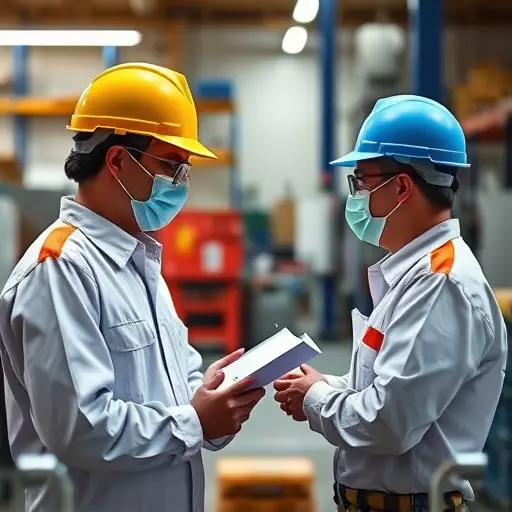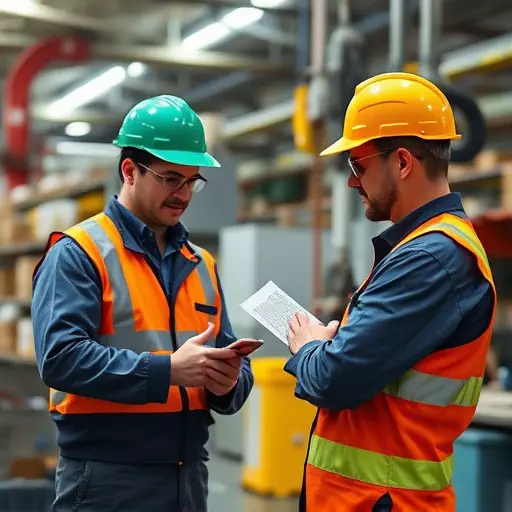Industrial hygiene consultants play a pivotal role in workplace hazard evaluations by identifying and mitigating risks using Occupational Exposure Limits (OELs) as guidelines. They assess hazardous substances, unsafe conditions, and repetitive tasks, ensuring adherence to OELs through inspections and data analysis. By implementing effective control measures, these consultants foster a culture of proactive safety awareness among employees. Regular monitoring, including air quality testing and record-keeping, is crucial for compliance and preventing occupational diseases or injuries. Consultants recommend tailored solutions like engineering controls and personal protective equipment (PPE), emphasizing their use to mitigate risks. Continuous reviews, data tracking, and stakeholder collaboration ensure organizations adapt their safety programs to changing environments and scientific findings.
Workplace hazard evaluation is a critical process aimed at ensuring employee safety and health. This comprehensive overview delves into essential aspects of identifying and managing risks in the workplace. From understanding the role of industrial hygiene consultants in pinpointing hazards to assessing risk and setting occupational exposure limits, each step plays a vital role in fostering a secure work environment. By implementing control measures and continually monitoring safety, organizations can effectively mitigate risks and establish best practices for robust hazard evaluation programs.
- Understanding Workplace Hazard Evaluation: A Comprehensive Overview
- The Role of Industrial Hygiene Consultants in Hazard Identification
- Assessing Risk: Recognizing Common Workplace Hazards
- Setting Occupational Exposure Limits: Protecting Employee Health
- Implementing Control Measures to Mitigate Risks
- Monitoring and Reviewing Workplace Safety Over Time
- Best Practices for Effective Hazard Evaluation Programs
Understanding Workplace Hazard Evaluation: A Comprehensive Overview

Workplace Hazard Evaluation is a critical process that involves identifying, assessing, and mitigating potential risks in the work environment. This systematic approach aims to ensure the health and safety of employees by minimizing exposure to various hazards. It is a comprehensive strategy that integrates industrial hygiene principles with regulatory requirements. Industrial hygiene consultants play a pivotal role here, as they are experts in evaluating and controlling occupational exposures.
By conducting thorough assessments, these professionals identify hazardous substances, unsafe conditions, or repetitive tasks that may cause injuries or illnesses. They then utilize established Occupational Exposure Limits (OELs) to determine safe levels of exposure for various risks. This evaluation process enables organizations to implement necessary controls, such as engineering controls, administrative measures, and personal protective equipment, thereby fostering a safer workplace culture.
The Role of Industrial Hygiene Consultants in Hazard Identification

Industrial hygiene consultants play a pivotal role in workplace hazard evaluations by identifying and assessing risks that may go unnoticed by everyday employees or management. They bring specialized knowledge and expertise to ensure a comprehensive understanding of potential hazards present in any work environment. Through meticulous observation and advanced analytical techniques, these consultants can uncover hidden dangers related to chemical exposures, noise levels, ergonomics, and more.
By conducting thorough inspections and analyzing air quality, biomechanics, and other factors, industrial hygiene consultants help organizations adhere to occupational exposure limits set by regulatory bodies. Their insights enable the implementation of effective control measures, ensuring employee safety and health. Moreover, they often provide valuable training and education to workforce members, empowering them to recognize and report potential hazards, fostering a culture of proactive safety awareness within the organization.
Assessing Risk: Recognizing Common Workplace Hazards

Assessing risk is a critical step in any comprehensive workplace hazard evaluation. Industrial hygiene consultants play a pivotal role in identifying and characterizing potential risks that may be present in various work environments. These experts leverage their deep knowledge of occupational exposure limits and industrial hygiene best practices to conduct thorough assessments, ensuring the safety and well-being of employees.
Common workplace hazards include noise exposure, chemical substances, ergonomic issues, and even psychosocial factors like stress and violence. By meticulously evaluating these risks, industrial hygiene consultants help organizations implement effective control measures. This proactive approach not only minimizes the likelihood of accidents and illnesses but also promotes a healthier, more productive work environment in alignment with established occupational exposure limits.
Setting Occupational Exposure Limits: Protecting Employee Health

Setting Occupational Exposure Limits plays a crucial role in protecting employee health during a workplace hazard evaluation. Industrial hygiene consultants emphasize that these limits, established by regulatory agencies and expert panels, define the maximum acceptable concentrations or levels of hazardous substances in the air or work environment. By adhering to these limits, organizations can minimize the risk of occupational diseases and injuries among their workforce.
Regular monitoring and assessment are essential to ensure compliance with occupational exposure limits. Industrial hygiene consultants recommend implementing robust surveillance programs that include air quality testing, medical surveillance of employees, and comprehensive record-keeping. These measures help identify potential breaches in safety protocols and allow for timely corrective actions, fostering a safer and healthier work environment.
Implementing Control Measures to Mitigate Risks

When conducting a workplace hazard evaluation, it’s crucial to identify not just potential risks but also implement effective control measures. Industrial hygiene consultants play a vital role in this process by assessing the specific hazards present and recommending strategies to mitigate them. This might involve engineering controls, such as improving ventilation systems or implementing automated processes to reduce manual handling of hazardous materials.
Additionally, administrative controls and personal protective equipment (PPE) are essential components of a comprehensive risk management strategy. Ensuring that workers are trained on proper use and maintenance of PPE, along with adhering to occupational exposure limits set by regulatory bodies, significantly reduces the risk of injuries or illnesses related to workplace hazards.
Monitoring and Reviewing Workplace Safety Over Time

Regular monitoring and reviewing of workplace safety over time are crucial components of any comprehensive workplace hazard evaluation process. Industrial hygiene consultants play a vital role in this regard, ensuring that organizations adhere to occupational exposure limits for various hazards. By conducting periodic assessments, these experts can identify potential risks that may have been overlooked or have evolved since the last evaluation. This proactive approach allows companies to implement necessary control measures and updates to safety protocols, thereby fostering a culture of continuous improvement.
Through ongoing surveillance, workplace safety professionals can track trends in exposure levels, worker complaints, and incident rates. Such data-driven insights enable informed decisions about engineering controls, personal protective equipment (PPE), and housekeeping practices. By reviewing this information over time, organizations can gauge the effectiveness of their safety programs and make adjustments to stay ahead of emerging risks, ultimately contributing to a safer and healthier work environment.
Best Practices for Effective Hazard Evaluation Programs

A robust workplace hazard evaluation program is a cornerstone of any organization committed to ensuring employee safety and health. To maximize effectiveness, such programs should be guided by several best practices recommended by industrial hygiene consultants. Firstly, involve all stakeholders, including employees at all levels, in the process. This collaborative approach fosters a culture of safety awareness and empowers workers to identify potential risks. Regular, comprehensive risk assessments are another critical component; these should consider not just immediate dangers but also long-term health impacts, incorporating insights from relevant occupational exposure limits.
Additionally, utilize advanced technologies and data analytics to identify trends and patterns in workplace hazards. This analytical rigor enables proactive measures rather than reactive responses to potential risks. Moreover, continuous training and education are vital; keeping employees informed about emerging risks and safety protocols ensures a dynamic and adaptable safety culture. Regular audits and reviews of the evaluation program itself are also essential, allowing for improvements based on changing work environments and new scientific findings.


